Whether commuting, running errands or just getting some exercise, bicycling is experiencing a resurgence in the United States.
Bikeshare and a Resurgence of the Bicycle
Bicycling infrastructure is relatively easy to implement and low-cost compared to other modes.
– Steve Towsen, City Engineer for City of Portland, OR
More people are getting back on their bikes and not just because May is bike month. Whether commuting, running errands or just getting some exercise, bicycling is experiencing a resurgence in the United States. And now in the growing number of cities with bikeshare programs, you don’t even need to own your own bike.
One of the obstacles to riding a bike is that many people don’t feel safe on our streets, which are often geared to cars, not people walking or biking. That’s changing. According to a recent ULI report, Active Transportation and Real Estate: The Next Frontier, the U.S. now boasts 1,700 rails-to-trails projects totaling more than 22,000 miles (35,400 km), and the federal government has funded 2,500 bike infrastructure projects. More than 900 cities have complete-streets policies benefitting all users.
It is generally only when cities invest in bicycle infrastructure that residents and visitors begin to use bicycles at rates that exceed the national average. In the 1980s and early 1990s, Portland, OR was a city much like any other in terms of transportation behavior. However, bicycle use there has grown exponentially: bicycle commuting since 1990 has grown by 400%, while transit has increased by 18% and driving has declined by 4%, according to the City’s transportation bureau.
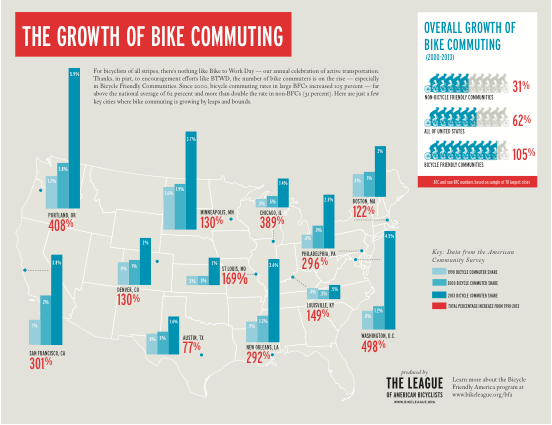
Steve Towsen, Portland’s city engineer, attributes the bicycling boom to investment in bicycle infrastructure, saying, “Bicycling infrastructure is relatively easy to implement and low-cost compared to other modes.”
Portland estimated the cost of its 300-mile network of bike trails, lanes and boulevards at approximately $60 million in 2008, which is about the same cost as one mile of a four-lane urban freeway.
Meanwhile, Minneapolis has invested in 129 miles of on-street bikeways and 97 miles of off-street bikeways that has spurred a 186% increase in bike commuting between 1990 and 2014. Even in winter, approximately one-third of regular commuters bike to work at least some of the time, according to Bike Walk Twin Cities.
These investments are paying off across the nation – the number of U.S. workers who commute to work by bicycle increased by roughly 62% between 2000 and 2014, according to the U.S. Census – a larger increase than that of any other commuting mode.
This growth in bikes comes at an opportune time for the planet. Growing awareness about the global warming effects of pollution, an increased awareness of the nation’s obesity epidemic, growing congestion and the costs associated with owning, operating and insuring a car (AAA found the national average at nearly $8,700 in 2015) have all played a role in catalyzing increased attention around the role of bicycling in making our transportation system cleaner and “healthier.”
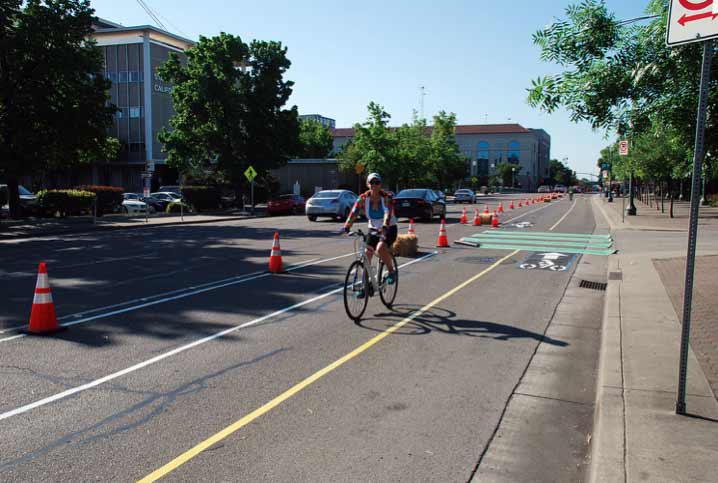
The European Cyclists Federation found that, if levels of cycling in the European Union were equivalent to those found in Denmark – where the average person cycles almost 600 miles each year – bicycle use alone would achieve 26% of the 2050 greenhouse-gas reduction targets set for the transportation sector.
And it’s not just the usual suspects fostering more bike riding – while the Northern California college town of Davis still holds on to its “bike city” credentials with the nation’s largest percentage of people commuting by bicycle at 23%, other communities across the country are seeing a huge growth in bike commuting.
The number of bicycle commuters in Oakland, for example, has more than doubled since 2007, and the city’s bikeway network has grown by 40%.
As part of its Bike to Work celebrations, Oakland added two more bike-friendly sections to the roadway. In addition to the Grand Avenue road diet, the new Telegraph Avenue Complete Streets Project was also launched, with the installation of the East Bay’s first urban streets protected bike lanes, in which bike lanes are placed next to the curb, where cars are normally parked – providing a buffer from moving traffic.
This month, LGC staff worked with the City of Stockton and consultants from Fehr and Peers to conduct a “living preview” demonstration to “test-ride” a cycle track-an on-street bicycle path separated from motor traffic.
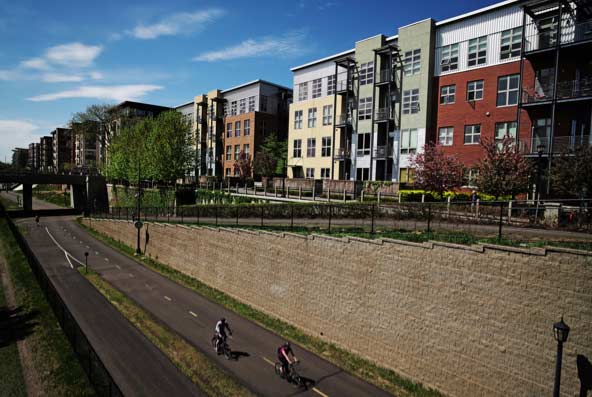
The City has a master plan that identifies where it would like to install new bike lanes within the city and expand its cycling community for both the casual and more serious rider.
“While not all streets have the capability to put cycling tracks in them, some of them do, and we want the community’s input on what they think of them,” said Public Works Director Gordon Mackay.
Cities competing to attract millennials and other people interested in active lifestyles are investing in bike infrastructure and amenities such as repair stations, showers and lockers, and community gathering spaces.
Now, “trail-oriented development,” such as that along the Midtown Greenway in Minneapolis, is drawing thousands of daily riders and many millions in real-estate investments, according to the ULI.
Bikeshare programs launching across the nation are another example of infrastructure investment helping to make bicycling more convenient and widespread.
There are currently at least 60 bike-share programs in the U.S., with more than 30,000 bikes covering 87 cities. Another 15 cities are in some stage of launching new programs.
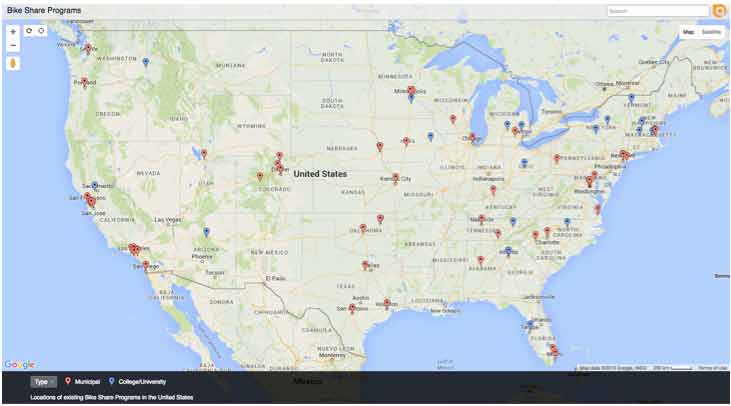
There are many reasons that communities are pursuing bicycle investments generally and bike-share programs in particular, including increasing physical activity and reducing car congestion, greenhouse gas emissions and dependence on fossil fuels.
Research on the impact of bikesharing in Saint-Paul/Minneapolis and Salt Lake City showed that more than 50% of bikeshare users reported driving less often.
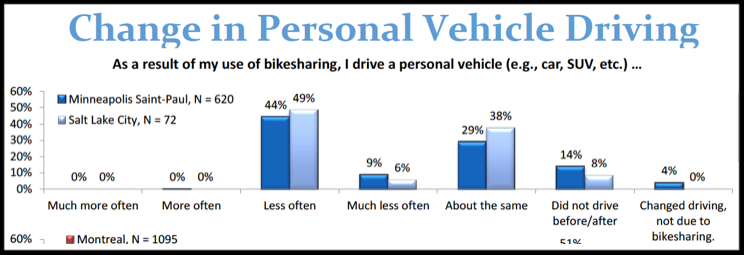
In conjunction with Bike Month and the growing interest in bikesharing, this issue will focus on considerations in creating programs that meet local health, climate and equity goals.
1. Ridership: Casual one-day or one-week users – typically tourists – pay the most per ride, while annual members pay a low, flat rate for unlimited short-distance trips. To maximize revenue, a system needs the right balance of annual members (who may pay pennies per trip) and casual ones (who subsidize them).
Austin, TX and Minneapolis, MN see more than 40% of walk-up riders from out-of-state, according to a Virginia Tech Capital Bikeshare study. In Washington, DC, 66% of walk-up riders are from outside the metro area.
2. Membership/Pricing: Many bikeshare systems are built around a tiered membership structure. In Washington, DC, annual members pay $75 for a year’s worth of access, and any trip under 30 minutes is free. About 98% of all trips taken by annual members last less than 30 minutes. Daily and weekly users far outnumber monthly and annual members in the system.
Casual riders make up a small share of all of the total trips taken but are responsible for a vast majority of the most lucrative long trips that bring in rapidly escalating overage fees.

For an equitable system, recent NACTO research highlights the fact that monthly payment options can help reduce barriers to entry.
In New York City, Citi Bike recently shifted its NYC Housing Authority discounted membership from $60/year to$5/month. Offering cash-based options also helps – in Philadelphia, Indego’s cash-based membership is used by a more diverse population of riders than the credit card option.
3. Funding Model: Capital Bikeshare funded their original bikes and the docking stations with federal grants earmarked for local programs that mitigate congestion and improve air quality. User fees cover a large share of the operating costs (repairing broken bikes, “rebalancing” bikes from full stations to empty ones, running the customer call center).
Capital Bikeshare is an efficient system, and the District expects to generate net profit on its portion of the system. However, bikeshare isn’t completely self-sustaining. Bikeshare, as a form of public transportation, is likely to require the kind of public support that buses and trains receive.
4. Weather: Changes in weather should also be considered when projecting revenue – lucrative casual users in New York’s Citi Bike took more than 202,000 summer trips in New York in August 2013; a few months later, in February 2014, a particularly bitter winter, they took fewer than 8,000 trips.
5. Station Locations: The National Association of City Transportation Officials found that station density is one of the biggest factors in the success of bike-sharing programs. Capital Bikeshare information from annual members in Washington, DC, shows that people don’t sign up if stations are more than one-quarter mile (a 3- to 5-minute walk) from either their home or work. Cities should consider equity in the placement of bikes.
For example, New York City’s Citi Bike stations are placed with the same high frequency in low-income areas and around NYC Housing Authority campuses as they are in wealthier Midtown Manhattan.
Bay Area Bike Share (Motivate) has been conducting public meetings and input to help identify the best locations for new stations as its regional program expands into the East Bay.
6. Build Supportive Infrastructure: While the number of protected bike lanes has quadrupled in the past five years, the overwhelming majority of streets lack safe space for people on bikes (especially in low-income neighborhoods).
Placing bikeshare stations near protected lanes, providing ample bike parking, and increasing lane miles and connectivity to improve the overall network will all improve the program’s viability and the safety of its users.
7. Connect to Transit: Bikeshare stations placed in close, visual proximity to transit stops can help people make their first mile/last mile connections. Providing a single fare card that covers all modes can also greatly improve connectivity.
8. Conduct Outreach: In Philadelphia, the Indego Community Ambassadors program hires locals with established community roots to organize events and help promote the system. In New York, public partnerships with community-based organizations and outreach around station siting has increased engagement.
9. Create Workforce Opportunities: Cities can integrate bikeshare into workforce development programs, training local residents for field and operations staff, skilled mechanics, call-center operators, marketing teams and senior management.
In Jersey City, NJ, bikeshare operator Motivate recruited its launch team through a program that specializes in reintegrating formerly incarcerated people into the workforce. In Portland, OR, 50% of bikeshare staff hours will go to populations that the City designates as “underserved.” Citi Bike employees who started via Recycle-a-Bicycle youth training programs are now part of the management teams in Boston and New York.

Bikeshare programs are just one of many ways communities can increase bicycling and should be pursued as part of a larger strategy to improve bike infrastructure and encourage healthier mobility options.
As communities invest in infrastructure and the number of cyclists increases, bicycling actually becomes safer, the rate of crashes drops and, in some cases, the absolute number of bicycle crashes also drops. From large urban areas such as New York City, to medium-sized Minneapolis and the more rural Marin County in California, motorists are becoming more bicycle aware and safety improves with more bicyclists on the road.
Local Government Commission Newsletters
Livable Places Update
CURRENTS Newsletter
CivicSpark™ Newsletter
LGC Newsletters
Keep up to date with LGC’s newsletters!
Livable Places Update – April
April’s article: Microtransit: Right-Sizing Transportation to Improve Community Mobility
Currents: Spring 2019
Currents provides readers with current information on energy issues affecting local governments in California.
CivicSpark Newsletter – March
This monthly CivicSpark newsletter features updates on CivicSpark projects and highlights.



